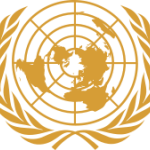- Sektör: NGO
- Number of terms: 31364
- Number of blossaries: 0
- Company Profile:
The United Nations Organization (UNO), or simply United Nations (UN), is an international organization whose stated aims are facilitating cooperation in international law, international security, economic development, social progress, human rights, and the achieving of world peace.
Strategy published by the International Union for Conservation of Nature and Natural Resources (IUCN) (currently the World Conservation Union), United Nations Environment Programme (UNEP) and the World Wide Fund for Nature (WWF) in 1980 with the objectives of (a) maintaining essential ecological processes and life support systems, (b) preserving genetic diversity and (c) ensuring the sustainable utilization of species and ecosystems. An updated version entitled Caring for the Earth.
Industry:Environment
1. Science that deals with the waters above and below the land surfaces of the earth, their occurrence, circulation and distribution, both in time and in space, their biological, chemical and physical properties, and their interaction with the environment including their relation to living beings. 2. Science that deals with the processes governing the depletion and replenishment of the water resources of the land areas of the earth including the various phases of the hydrologic cycle.
Industry:Environment
Any substance or mixture of substances that is used to prevent, destroy or control pests - including vectors of human or animal disease, and unwanted species of plants or animals. Pesticides may cause harm during, or otherwise interfere with, the production, processing, storage, transport or marketing of food, agricultural commodities, wood and wood products or animal feedstuffs - or that may be administered to animals so as to control insects, arachnids or other pests in or on their bodies.
Industry:Environment
(a) Environmental functions of forest or other wooded areas that include protection of the soil against erosion, water flow control, air purification, wind shelter, noise abatement, preservation of habitats, protection of species of fauna and flora, preservation of wildlife forage grounds and other biological uses, (b) economic functions of the production of timber and other forestry products and recreational activities and (c) social functions, for example, of an aesthetic or religious nature.
Industry:Environment
Second step in most waste treatment systems during which bacteria consume the organic parts of the wastes. This is accomplished by bringing the sewage, bacteria and oxygen together in trickling filters or within an activated sludge process. Secondary treatment removes all floating and settleable solids and about 90 per cent of the oxygen-demanding substances and suspended solids. Disinfection by chlorination is the final stage of the secondary treatment process. See also tertiary treatment.
Industry:Environment
Economic concept of uncompensated environmental effects of production and consumption that affect consumer utility and enterprise cost outside the market mechanism. As a consequence of negative externalities, private costs of production tend to be lower than its "social" cost. It is the aim of the "polluter/user-pays" principle to prompt households and enterprises to internalize externalities in their plans and budgets. See also economic instruments and internalization of environmental costs.
Industry:Environment
Pungent, colourless, toxic gas that contains three atoms of oxygen in each molecule. It occurs naturally at a concentration of about 0.01 parts per million (p.p.m.) of air. Levels of 0.1 p.p.m. are considered to be toxic. In the stratosphere, ozone provides a protective layer shielding the earth from the harmful effects of ultraviolet radiation on human beings and other biota. In the troposphere, it is a major component of photochemical smog, which seriously affects the human respiratory system.
Industry:Environment
Maximum number of animals of one or more species that can be supported by a particular habitat or area through the most unfavourable period of the year. The carrying capacity is different for each species in a habitat because of particular food, shelter, and social requirements and because of competition from other species that may have similar requirements. Attempts have been made to apply carrying capacity analysis to the human population in particular territories. See also ecological footprint.
Industry:Environment
The rate to discount future income in the net present-value method of valuing natural resource assets. The discount rate expresses the degree to which an economic agent prefers income today rather than in the future. This time preference will vary depending on the agent in question. In general, individuals and businesses have higher rates of time preference than governments. In addition to time preference, discount rates can also reflect risks associated with the future returns expected from an investment.
Industry:Environment
Distinction is made between renewable and non-renewable water resources. Non-renewable water resources are not replenished at all or for a very long time by nature. This includes the so-called fossil waters. Renewable water resources are rechargeable due to the hydrological cycle unless they are overexploited, comprising groundwater aquifers and surface water like rivers and lakes. Internal renewable water resources comprise the average annual flow of rivers and groundwater generated from endogenous precipitation.
Industry:Environment
